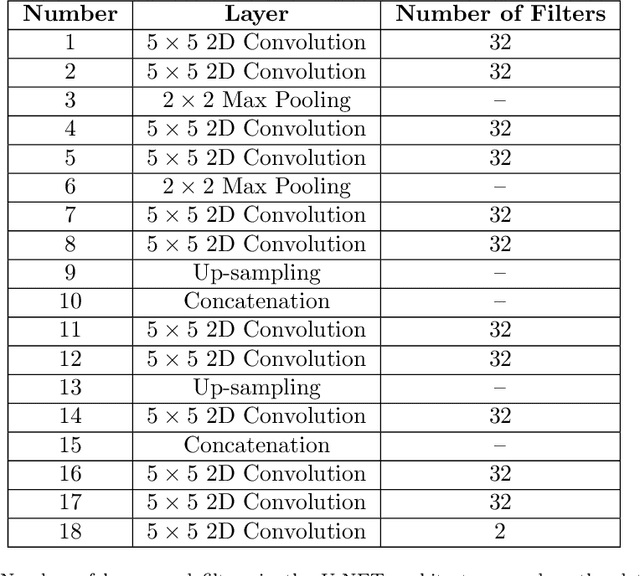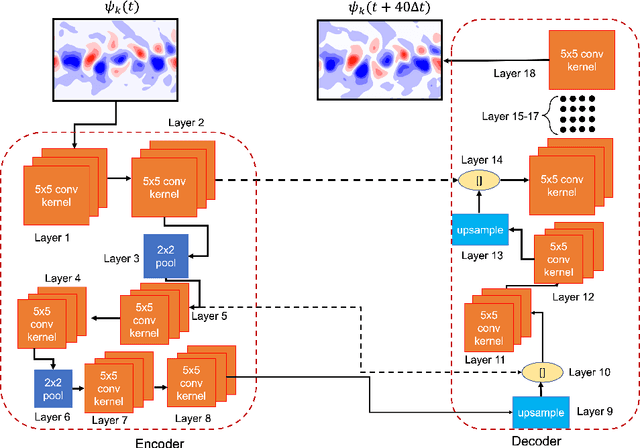Ebrahim Nabizadeh
Deep learning-enhanced ensemble-based data assimilation for high-dimensional nonlinear dynamical systems
Jun 09, 2022


Abstract:Data assimilation (DA) is a key component of many forecasting models in science and engineering. DA allows one to estimate better initial conditions using an imperfect dynamical model of the system and noisy/sparse observations available from the system. Ensemble Kalman filter (EnKF) is a DA algorithm that is widely used in applications involving high-dimensional nonlinear dynamical systems. However, EnKF requires evolving large ensembles of forecasts using the dynamical model of the system. This often becomes computationally intractable, especially when the number of states of the system is very large, e.g., for weather prediction. With small ensembles, the estimated background error covariance matrix in the EnKF algorithm suffers from sampling error, leading to an erroneous estimate of the analysis state (initial condition for the next forecast cycle). In this work, we propose hybrid ensemble Kalman filter (H-EnKF), which is applied to a two-layer quasi-geostrophic flow system as a test case. This framework utilizes a pre-trained deep learning-based data-driven surrogate that inexpensively generates and evolves a large data-driven ensemble of the states of the system to accurately compute the background error covariance matrix with less sampling error. The H-EnKF framework estimates a better initial condition without the need for any ad-hoc localization strategies. H-EnKF can be extended to any ensemble-based DA algorithm, e.g., particle filters, which are currently difficult to use for high dimensional systems.
Long-term stability and generalization of observationally-constrained stochastic data-driven models for geophysical turbulence
May 09, 2022



Abstract:Recent years have seen a surge in interest in building deep learning-based fully data-driven models for weather prediction. Such deep learning models if trained on observations can mitigate certain biases in current state-of-the-art weather models, some of which stem from inaccurate representation of subgrid-scale processes. However, these data-driven models, being over-parameterized, require a lot of training data which may not be available from reanalysis (observational data) products. Moreover, an accurate, noise-free, initial condition to start forecasting with a data-driven weather model is not available in realistic scenarios. Finally, deterministic data-driven forecasting models suffer from issues with long-term stability and unphysical climate drift, which makes these data-driven models unsuitable for computing climate statistics. Given these challenges, previous studies have tried to pre-train deep learning-based weather forecasting models on a large amount of imperfect long-term climate model simulations and then re-train them on available observational data. In this paper, we propose a convolutional variational autoencoder-based stochastic data-driven model that is pre-trained on an imperfect climate model simulation from a 2-layer quasi-geostrophic flow and re-trained, using transfer learning, on a small number of noisy observations from a perfect simulation. This re-trained model then performs stochastic forecasting with a noisy initial condition sampled from the perfect simulation. We show that our ensemble-based stochastic data-driven model outperforms a baseline deterministic encoder-decoder-based convolutional model in terms of short-term skills while remaining stable for long-term climate simulations yielding accurate climatology.
Analog forecasting of extreme-causing weather patterns using deep learning
Jul 26, 2019



Abstract:Numerical weather prediction (NWP) models require ever-growing computing time/resources, but still, have difficulties with predicting weather extremes. Here we introduce a data-driven framework that is based on analog forecasting (prediction using past similar patterns) and employs a novel deep learning pattern-recognition technique (capsule neural networks, CapsNets) and impact-based auto-labeling strategy. CapsNets are trained on mid-tropospheric large-scale circulation patterns (Z500) labeled $0-4$ depending on the existence and geographical region of surface temperature extremes over North America several days ahead. The trained networks predict the occurrence/region of cold or heat waves, only using Z500, with accuracies (recalls) of $69\%-45\%$ $(77\%-48\%)$ or $62\%-41\%$ $(73\%-47\%)$ $1-5$ days ahead. CapsNets outperform simpler techniques such as convolutional neural networks and logistic regression. Using both temperature and Z500, accuracies (recalls) with CapsNets increase to $\sim 80\%$ $(88\%)$, showing the promises of multi-modal data-driven frameworks for accurate/fast extreme weather predictions, which can augment NWP efforts in providing early warnings.
 Add to Chrome
Add to Chrome Add to Firefox
Add to Firefox Add to Edge
Add to Edge